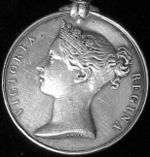Indian Mutiny Medal
| Indian Mutiny Medal | |
|---|---|
|
Obverse (top left) and reverse (top right) of the medal. Ribbon: 32mm, white with two red stripes. | |
| Awarded by United Kingdom of Great Britain and Ireland | |
| Type | Campaign medal |
| Eligibility | British and Indian forces. |
| Awarded for | Campaign service. |
| Campaign | Indian Mutiny 1857-58. |
| Description | Silver disk, 36mm diameter. |
| Clasps |
|
| Statistics | |
| Established | 1858 |
| Total awarded | 290,000 |
 Example of medal with Lucknow clasp. | |
The Indian Mutiny Medal was a campaign medal approved in 1858,[1] for issue to officers and men of British and Indian units who served in operations in suppression of the Indian Mutiny.
The medal was initially sanctioned for award to those troops who had been engaged in action against the mutineers. However, in 1868 the award was extended to all those who had borne arms or who had been under fire,[2] including such people as members of the Indian judiciary and the Indian civil service, who were caught up in the fighting.[3] Some 290,000 medals were awarded.[4]
The obverse of the medal depicts the head of a young Queen Victoria and bears the inscription Victoria Regina. The reverse shows a helmeted Britannia holding a wreath in her right hand and a union shield on her left arm. She is standing in front of a lion. The words "India 1857-1858" are inscribed on the reverse of the medal. The ribbon is white with two scarlet stripes.
Five clasps were authorised, though the maximum awarded to any one man was four.[5] The medal was issued without a clasp to those who served but were not eligible for a clasp. The vast majority of these awards were made to those who became entitled to the medal as a result of the 1868 extensions of eligibility.
Clasps
- Delhi
- 30 May - 14 September 1857. Awarded to troops participating in the recapture of Delhi.
- Defence of Lucknow
- 29 June - 22 November 1857. Awarded to original defenders and to the relief force commanded by Sir Henry Havelock - Particularly rare and sought after by collectors. This medal was also awarded to the principal, masters and schoolboys from La Martinière College in Lucknow[6]
- Relief of Lucknow
- November 1857. Awarded to the relief force under the command of Sir Colin Campbell.
- Lucknow
- November 1857 - March 1858. Awarded to troops under command of Sir Colin Campbell who were engaged in final operations leading to the surrender of Lucknow and the clearing of the surrounding areas.
- Central India
- January - June 1858. Awarded to all those who served under Major-General Sir Hugh Rose in actions against Jhansi, Kalpi, and Gwalior. Also awarded to those who served with Major-General Roberts in the Rajputana Field Force and Major-General Whitlock of the Madras Column, between January and June 1858.
The die for the medal was engraved by Leonard Charles Wyon.
Notes
- ↑ Authorisation contained in General Order 363 of 1858 and General Order 733 of 1859
- ↑ General Order 771 of 1868, see British Battles and Medals, p136
- ↑ John Sly. "Battle Stars". Ancestors, issue 57, May 2007, pp36-43.
- ↑ British Battles and Medals, p136
- ↑ Medal Yearbook 2004, p137
- ↑ List of the boys and staff who received the medal Archived June 8, 2007, at the Wayback Machine.
Bibliography
- Mackay, J and Mussel, J (eds) - Medals Yearbook - 2006, (2005), Token Publishing.
- Joslin, Litherland, and Simpkin (eds), British Battles and Medals, (1988), Spink
External links
*

